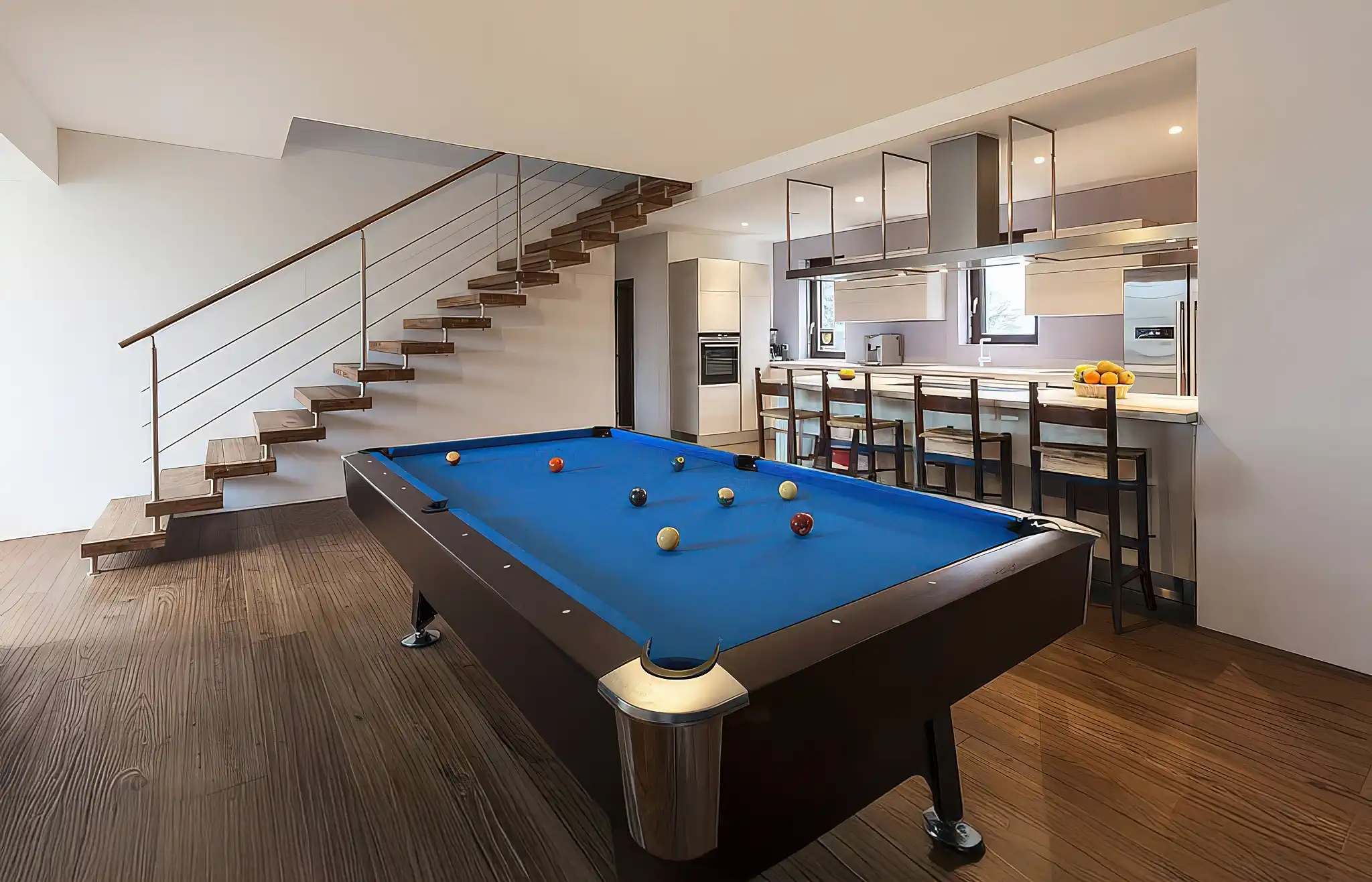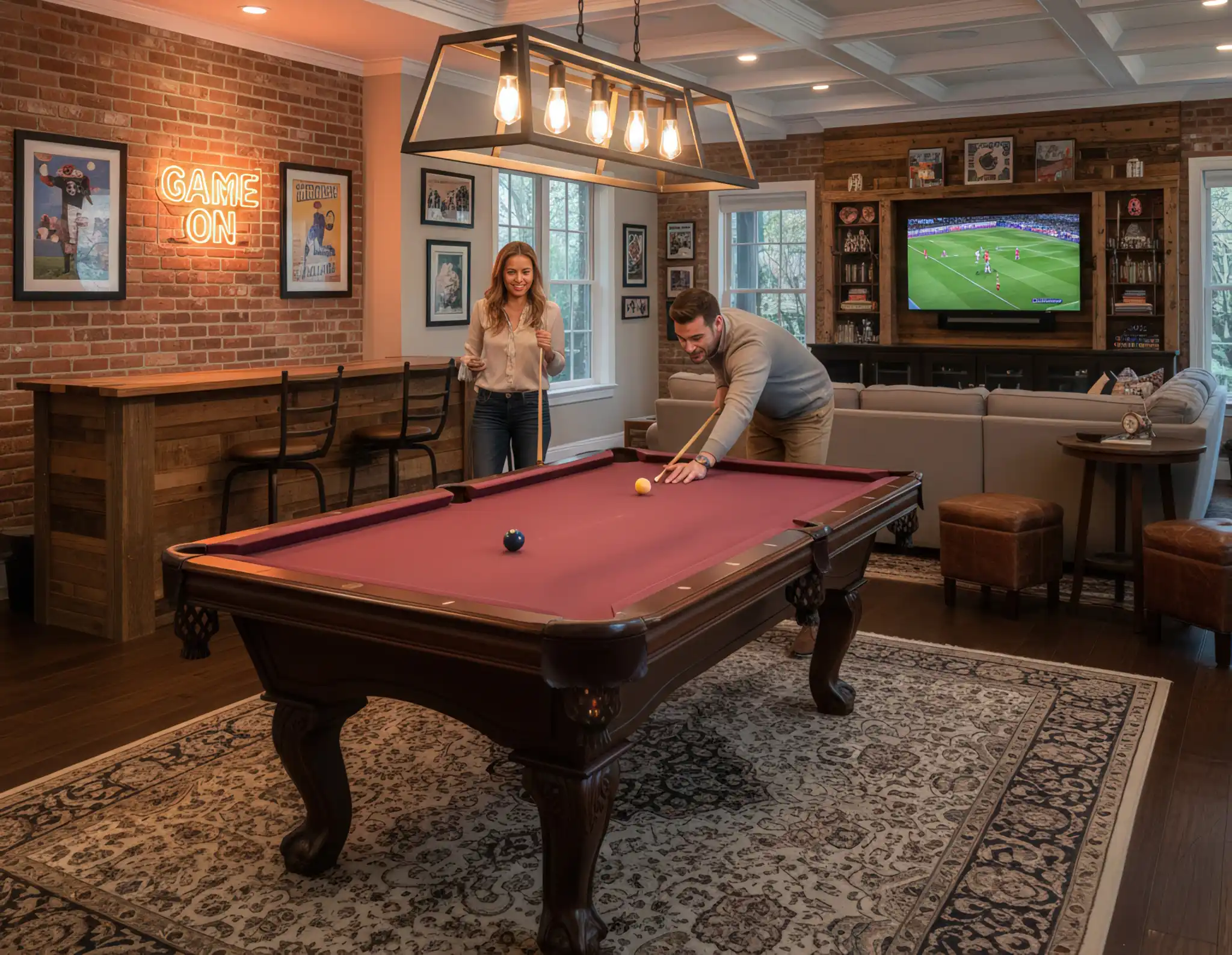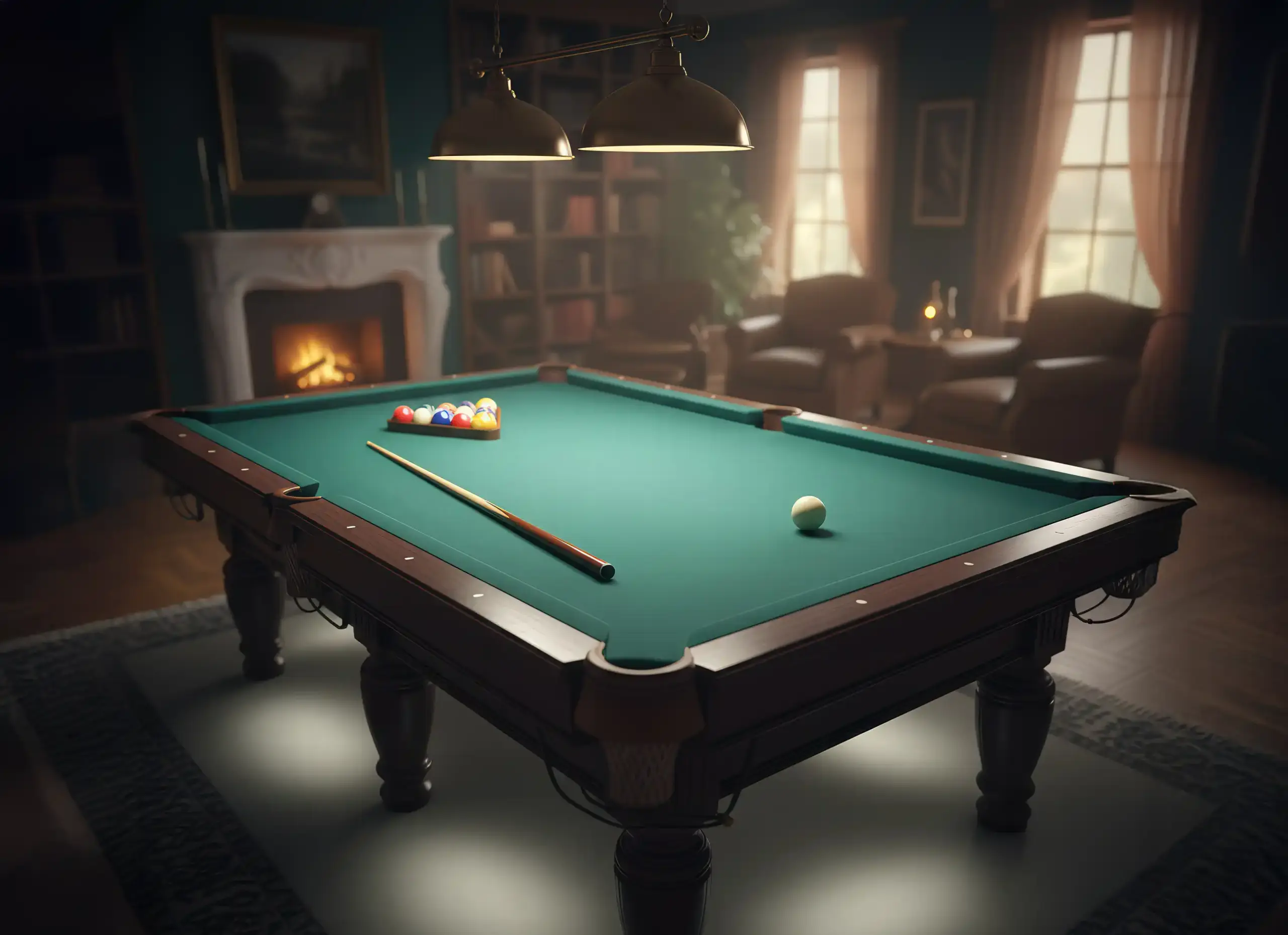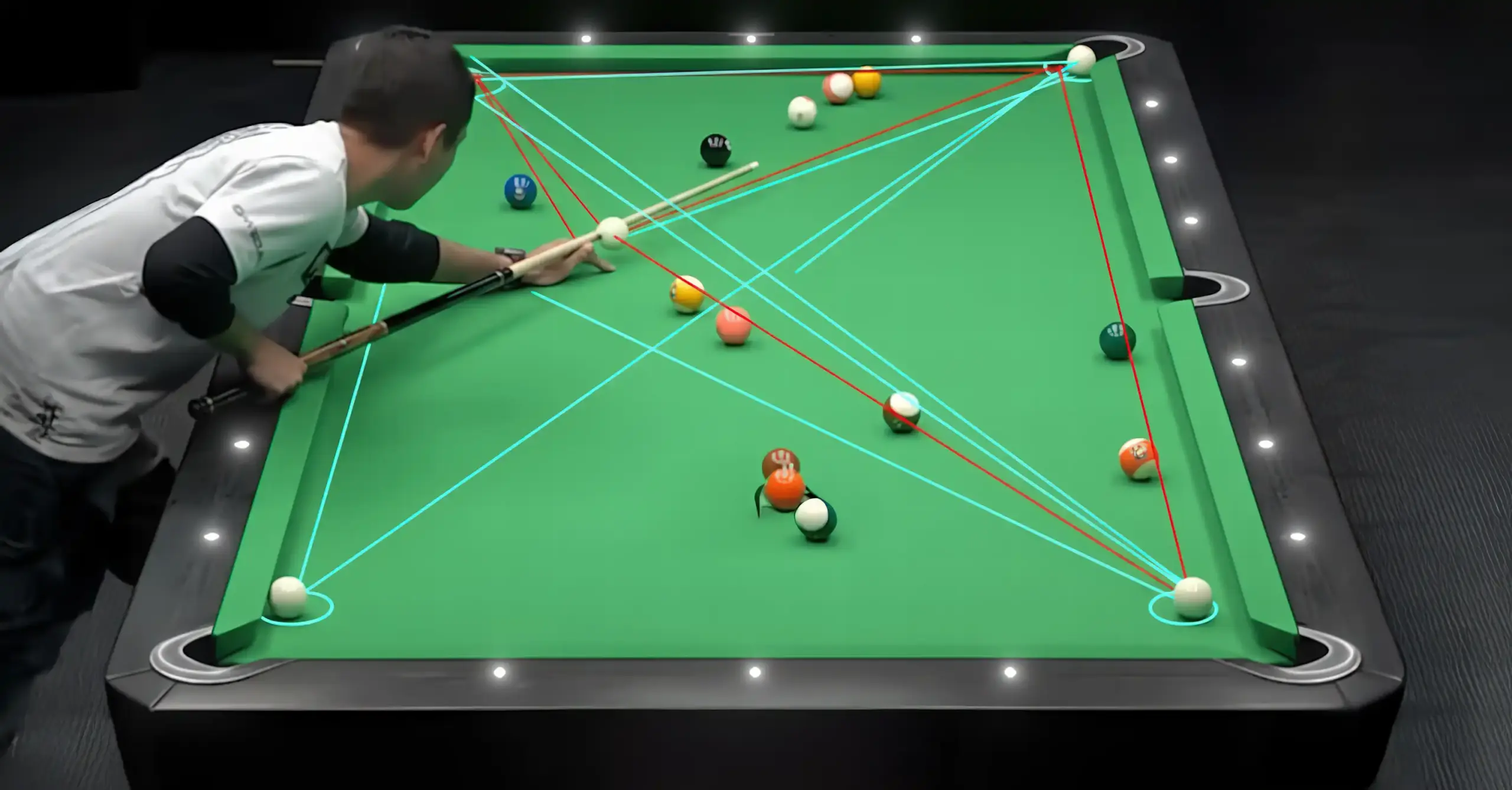Creating the ultimate entertainment hub at home is an exciting prospect. The modern game room is more than just a place to play; it’s a sanctuary for leisure, competition, and connection. However, designing a space that seamlessly blends the classic appeal and specific spatial needs of a pool table with the focused requirements of modern gaming setups presents unique challenges. This guide offers expert game room decor ideas to transform your space into a functional, stylish, and cohesive haven, perfectly balancing billiards, video games, and more.
Introduction
Are you dreaming of a dedicated space for fun and relaxation but struggling with how to make diverse activities like pool and digital gaming coexist harmoniously? You’re not alone. The core challenge lies in reconciling the open area needed for comfortable pool play with the often more contained environment desired for a gaming zone setup. Thoughtful design, focusing on layout, lighting, and style, is the key to unlocking your room’s potential. Whether envisioning a high-tech den or a traditional game parlor, these game room decor ideas will help you craft an entertainment space that caters to all your favorite pastimes.
Foundation First: Planning Your Perfect Game Room
Before diving into decor, defining your game room’s identity is crucial. Will it be a family-friendly hub, a sophisticated adult retreat, a high-tech gaming den, or a versatile multi-purpose zone? Clarifying the primary function helps prioritize which games and activities the space must accommodate – pool, video gaming (console/PC), tabletop games, arcade machines, darts, or shuffleboard. Consider if the room needs to double as a media center or general living area.
The chosen location—be it a basement, attic, spare room, or converted garage—significantly impacts design.
- Basements: Offer seclusion and space but need careful lighting and soundproofing.
- Attics: Can have charming architectural features but require attention to ventilation and access.
- Garages: Provide ample square footage but need insulation and finishing.
- Spare Rooms: Integrate well but may need noise control.
Consider ceiling height (especially for game room lighting over pool tables), natural light availability, soundproofing needs, and how the room’s style will connect with the rest of your home.
Spatial Strategy: Mastering Game Room Layout and Zoning
Effective game room layout hinges on zoning – creating distinct areas for different activities while maintaining flow.
The Art of Zoning
Designate specific areas for pool, video gaming, spectator seating, a bar/snack station, and tabletop games. Use techniques like:
- Furniture arrangement (e.g., seating grouped around a TV).
- Area rugs to visually anchor zones.
- Varied lighting (task lighting for pool, ambient for lounging).
- Partitions or open shelving (in larger spaces).
Plan zones for comfortable circulation and minimal interference between activities.
The Pool Zone: Critical Pool Table Clearance
This is non-negotiable for playability. Insufficient space damages cues and walls. Standard cues (57-58 inches) require more room than shorter cues (48 or 52 inches).
- Rule of Thumb: Allow at least 5 feet (60 inches) of clear space around all sides of the playing surface for standard cues.
- Calculation:
Room Width = Table Width + (2 x Cue Length);
Room Length = Table Length + (2 x Cue Length). - Measure carefully, accounting for intrusions like columns. Never place a table directly against a wall. Choosing a slightly smaller table that fits is better than cramping a larger one.
Pool Table Minimum Room Size Requirements (Approx. for 58″ Cue)
| Table Size | Playing Surface | Min. Room Size |
| 7-Foot | 38″ x 76″ | 13′ 0″ x 16′ 0″ |
| 8-Foot | 44″ x 88″ | 13′ 6″ x 17′ 0″ |
| 9-Foot | 50″ x 100″ | 14′ 0″ x 18′ 0″ |
The Gaming Zone Setup: Ergonomics and Flow
Design the gaming zone setup for comfort and function.
- Console Gaming: Mount TVs at eye level for seated viewers. Use comfortable sofas, sectionals, or ergonomic gaming chairs.
- PC Gaming: Requires a dedicated desk with space for monitors, peripherals, and potentially cooling systems. An ergonomic chair is essential.
- VR Gaming: Needs a clear, open area free of obstructions.
- Other Games: Plan space for arcade cabinets, pinball machines, or a dedicated table for board/card games.
- Audio: Consider quality speakers or surround sound.
- Traffic Flow: Ensure easy movement around gaming stations.
Integrating Ancillary Zones: Bars, Snacks, and Spectator Seating
Elevate functionality with added zones:
- Home Bars: From full wet bars to compact carts. Require appropriate spectator seating like bar stools.
- Snack Stations: Mini-fridge, popcorn machine, or designated counter.
- Spectator Seating: Crucial near the pool table. Taller spectator chairs or benches, often with cue rests and cup holders, offer the best view. Ample lounge seating serves spectators in the media/gaming zone. Aim for “right-height” seating throughout for easy conversation.
Defining the Vibe: Game Room Styles, Themes, and Color
Choose an aesthetic that sets the tone for your game room decor ideas.
Popular Game Room Styles
- Modern: Minimalist (clean lines, neutral palette), Industrial (raw materials like brick/metal, exposed elements), Mid-Century Modern (organic shapes, wood tones).
- Rustic: Reclaimed wood, natural textures, stone accents, cozy feel.
- Retro Arcade/Vintage: Bright colors, neon, vintage posters, classic game machines.
- Sports Bar: Large screens, memorabilia display, comfortable group seating, prominent bar.
- Classic/Traditional: Rich dark woods, leather, plush fabrics, pub-style elements, sophisticated feel.
- Eclectic: A mix of styles unified by color, texture, or formality.
Blending Styles Harmoniously
Integrating a classic pool table with modern gaming tech requires strategy:
- Use a unifying color palette across zones.
- Repeat materials or textures (e.g., same wood tone or metal finish).
- Choose transitional furniture styles.
- Decide if the room’s style blends with the home or is a distinct theme.
The Power of Color
Color dramatically impacts mood and perceived space:
- Moody/Sophisticated: Deep blues, charcoal grays, rich greens, black (ideal for focus, home theaters).
- Light/Airy: Whites, light grays, creams (makes small rooms feel larger, clean backdrop).
- Energetic/Bold: Vibrant reds, blues, purples, neons (playful, stimulating, great for retro themes).
- Themed Palettes: Use team colors for sports bars, earthy tones for rustic styles.
Always test paint colors under the room’s actual game room lighting.
Furnishing for Function and Flair: Game Room Furniture
Select game room furniture that anchors zones, provides comfort, offers storage, and reinforces your chosen style.
Anchoring the Room: Pool Tables and Gaming Stations
- Pool Tables: Choose a style (traditional, modern, rustic) that complements your theme. Consider multi-functional tables (dining/ping-pong conversion) for smaller spaces. Ensure the size allows for proper pool table clearance. Pool Table Store is the authorized dealer for quality brands like Brunswick Billiards in the GTA.
- Gaming Stations: Media consoles for TVs/consoles, dedicated desks for PCs, or statement pieces like arcade cabinets. Plan for power and cable management.
The Seating Scenario: Comfort and Views
Provide varied seating:
- Active Gaming: Ergonomic gaming chairs, floor rockers.
- Lounge/Media: Sofas, sectionals, recliners, bean bags.
- Spectator Seating: Taller spectator chairs/benches near the pool table (often with cue rests/cup holders), comfortable lounge seating near gaming areas.
- Bar/Table: Bar stools or chairs at the appropriate height.
Game Room Storage Solutions
Effective game room storage is essential:
- Media/Consoles: Media consoles, AV stands, entertainment centers, specialized racks.
- Games: Bookshelves, cabinets, game closets, built-in shelving.
- Accessories: Drawers, bins, wall-mounted racks, storage ottomans for controllers, headsets, etc.
- Pool Equipment: Wall-mounted or floor-standing cue racks (available in various styles – rustic wood, modern metal, industrial pipe), ball storage, triangle hooks.
- Bar: Cabinetry, shelving, back bar units for glassware, bottles, tools.
Maximize vertical space in smaller rooms.
Matching Furniture to Your Theme
Ensure furniture choices reinforce the aesthetic:
- Classic: Dark wood, leather, ornate details.
- Industrial: Metal and wood combinations, raw finishes.
- Modern: Clean lines, neutral palettes, minimalist forms.
- Rustic: Natural/reclaimed wood, textured fabrics.
- Retro: Bold colors, unique shapes, chrome accents.
Lighting the Scene: Effective Game Room Lighting
A layered game room lighting plan is crucial for function and ambiance.
The Ambient-Task-Accent Framework
- Ambient: General room illumination (ceiling fixtures, recessed lights, sconces). Sets the base mood.
- Task: Focused light for activities (pool table, gaming desk, bar). Ensures visibility.
- Accent: Highlights features (art, collectibles, decor). Adds drama and visual interest.
Essential Task Lighting
- Pool Table: Specialized billiard lights (linear pendants or multi-light fixtures) hung 30-36 inches above the playing surface are ideal for even, glare-free illumination. Track or recessed lighting can work but requires careful placement.
- Gaming Desks: Desk lamp or focused overhead light.
- Tabletop Games: Pendant light or adjustable floor/table lamp.
- Bar Areas: Pendants or under-cabinet lighting.
Adding Drama with Accent Lighting
- LED Strip Lights: Behind TVs (bias lighting), under shelves/counters, in coves. Often color-changing.
- Neon Signs: Classic game room vibe, great for bar areas or themed decor.
- Picture Lights: Illuminate artwork or memorabilia.
- Spotlights: Highlight architectural details or collectibles.
- Unique Fixtures: Lava lamps, themed lamps.
Control and Customization
- Dimmers: Essential for adjusting light levels for different activities (bright for pool, dim for movies). Install on all layers if possible.
- Smart Lighting: Offers presets, color changes, and app/voice control for ultimate flexibility.
Lighting is key to defining zones and modulating atmosphere, supporting the game room layout.
The Finishing Touches: Materials, Decor, and Accessories
Final elements tie the room together.
Walls and Floors: Setting the Background
Choose durable and stylish surfaces.
- Wall Treatments: Paint, wallpaper (patterns, murals), wood paneling, exposed brick, acoustic panels (for sound absorption).
- Game Room Flooring: Balance durability, comfort, and acoustics.
- Luxury Vinyl Plank (LVP): Durable, water-resistant, wood look, good for basements.
- Carpet Tiles: Comfortable, excellent sound absorption, replaceable.
- Rubber Flooring: Highly durable, shock-absorbent, good for basements/heavy equipment.
- Hardwood: Classic look, needs rugs for protection/acoustics.
- Concrete: Durable, industrial look, needs rugs for warmth/acoustics.
Game Room Flooring Comparison
| Flooring Type | Key Characteristics | Best Suited For |
| LVP | Durable, water-resistant, wood look | High traffic, basements, versatile styles |
| Carpet Tiles | Comfortable, sound absorption, design flex | Noise reduction, comfort priority |
| Rubber | Highly durable, shock-resistant | Basements, heavy equipment areas, durability focus |
Functional Decor and Game Room Storage
Accessorize smartly:
- Pool Area: Stylish wall-mounted cue racks (wood, metal, industrial pipe), scoreboards (bead scorers, flip boards, digital displays). These double as game room storage and decor.
- Gaming Area: Cable management solutions (ties, sleeves, trays, boxes), headphone stands, controller charging stations/stands.
Personalizing the Space
Infuse personality:
- Wall Art: Framed posters (games, movies), vintage ads, sports memorabilia, murals, art prints.
- Collectibles: Display figures, models, vintage consoles in lit cabinets or on shelves.
- Neon/LED: Signs add ambiance and reinforce themes.
- Themed Decor: Throw pillows, blankets, rugs, curtains, themed lamps matching your game room styles.
Bar and Snack Areas
Integrate these socially hubs:
- Match bar style and finishes to the room’s theme.
- Include adequate storage (glassware, bottles) and practical features (mini-fridge, sink if wet bar).
- Choose appropriate spectator seating like bar stools.
- Keep snack stations simple and stocked.
FAQ
How much space do I really need around my pool table?
- The absolute minimum for comfortable play with standard 58-inch cues is about 5 feet (60 inches) of clear space on all sides of the table’s playing surface. Using shorter cues can reduce this requirement slightly. Always measure your available space carefully, accounting for any obstructions.
What’s the best lighting for a pool table?
- Specialized billiard lights, typically linear pendant fixtures or chandeliers with multiple downward-facing shades, are best. They should be hung 30-36 inches above the playing surface to provide even, bright illumination without casting shadows or creating glare.
How can I make a modern gaming setup fit with a traditional pool table?
- Use unifying elements like a consistent color palette across both zones. Repeat materials, such as using the same wood finish found on the pool table for shelves near the gaming desk. Choose transitional furniture styles that blend classic and contemporary looks.
Conclusion
Designing a game room that successfully combines pool, gaming, and socializing requires thoughtful planning across layout, style, furniture, lighting, and finishes. By defining the room’s purpose, mastering spatial zoning with adequate pool table clearance, choosing a cohesive style, selecting functional game room furniture and game room storage, layering game room lighting effectively, and adding personalized decor, you can create more than just a place to play. You can build a personalized entertainment sanctuary. These game room decor ideas provide a roadmap, but your creativity and personal touches will make the space truly unique and enjoyable for years to come.
For expert advice on selecting the perfect pool table and game room furnishings in the Greater Toronto Area, contact Pool Table Store today or learn more on the Pool Table Store website.





